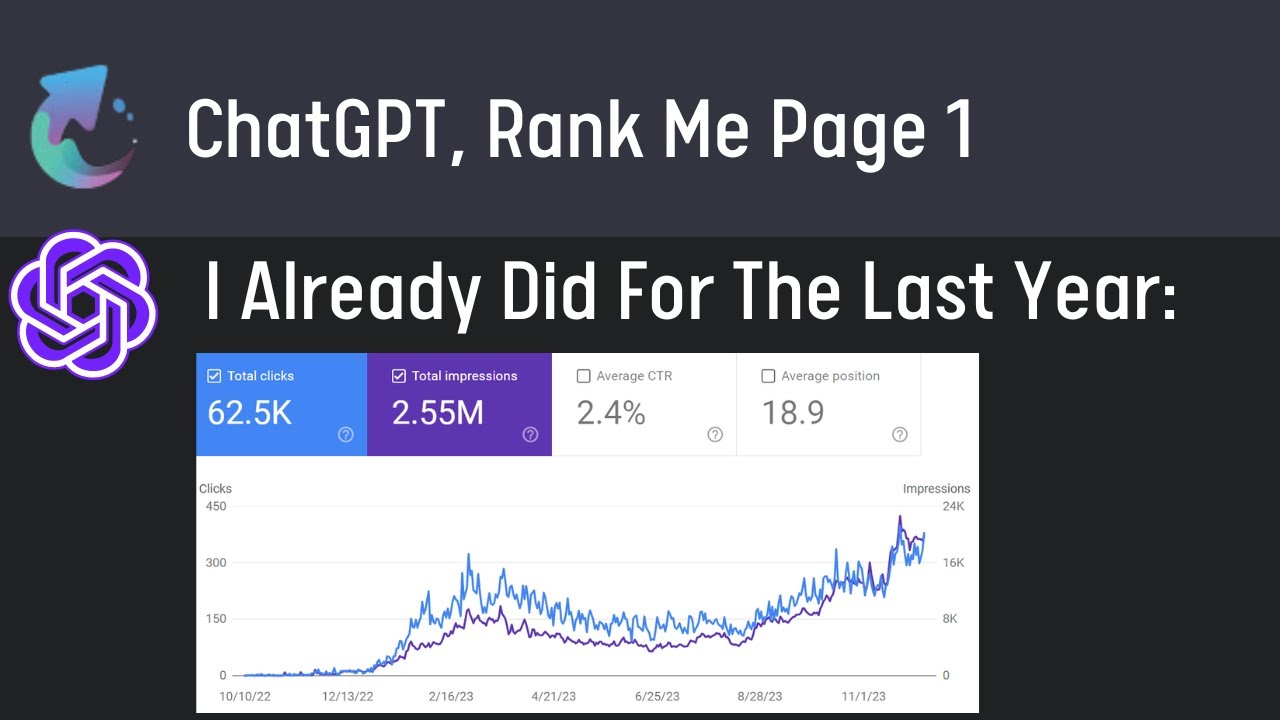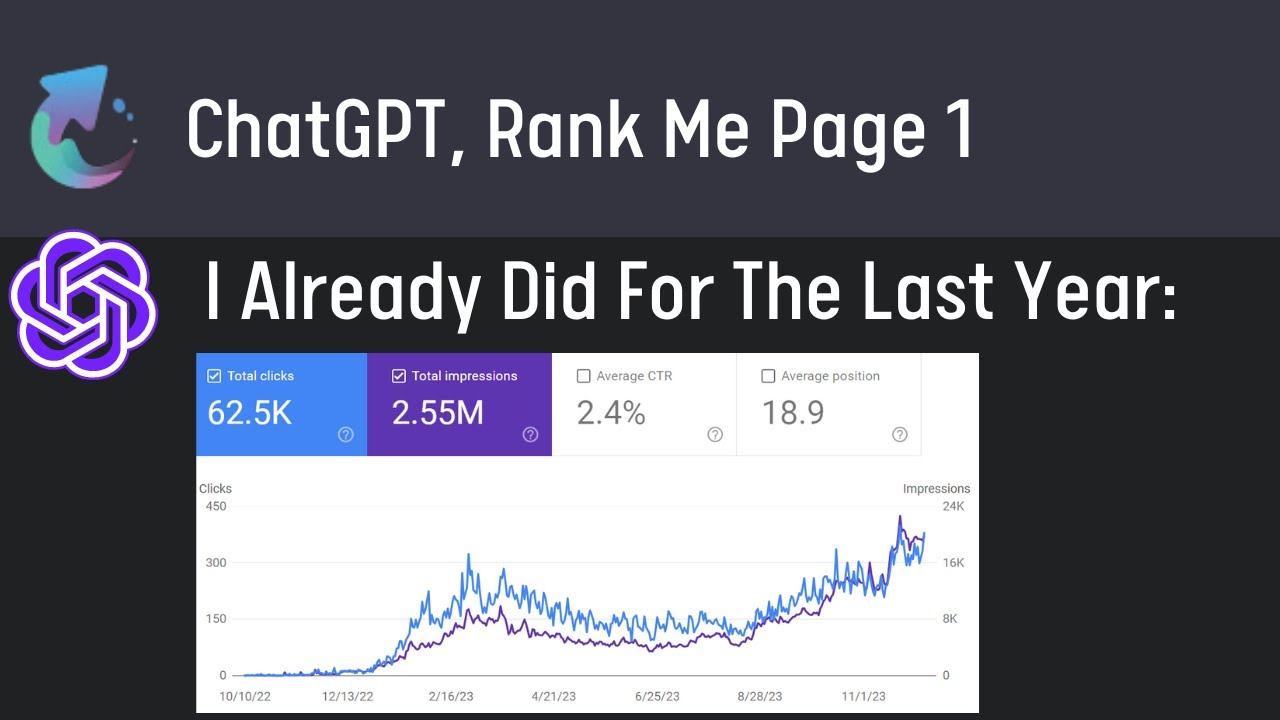In the video titled “How to Rank Content on Google with SEO: A ChatGPT Masterclass” by Income stream surfers, you’ll find a condensed guide on how to optimize your blog posts for better ranking on Google. The video introduces ChatGPT SEO as a useful tool that can automate the optimization process without costing you a fortune. With examples and success stories, the author stresses the importance of a featured image, unique design, relevant keywords in the title, regular content updates, and internal linking for improved user experience and potential featured snippets. They also discuss the value of including unique content and images on your webpage and provide examples of articles written using their automated system or Shopify plugins.
In their comprehensive masterclass, Income stream surfers walk you through 6 years of blog post optimization knowledge in just 13 minutes. You’ll learn how to effectively optimize your articles without relying on expensive overoptimization tools that don’t actually help you rank on Google. From creating captivating featured images and utilizing table of contents to incorporating relevant keywords in the title and updating your content regularly, this video has you covered. Discover the strategies that have led to their consistently performing article with high impressions and clicks, and see how you can implement these techniques for free.

Optimizing the Article Design
Importance of a Featured Image
When it comes to optimizing an article for better ranking on Google, one of the key elements you shouldn’t overlook is the use of a featured image. A featured image serves as the visual representation of your article and plays a crucial role in attracting readers’ attention. It adds visual appeal and makes your article stand out amidst a sea of text.
To make your featured image even more effective, consider adding some text to it. This text can provide a brief summary or a catchy headline that captures the essence of your article. Make sure the text is concise, engaging, and relevant to the content of your article. By doing so, you can enhance the visual impact of your featured image and give readers a glimpse of what they can expect from your article.
Remember, uniqueness is key when it comes to selecting a featured image. Avoid using generic stock photos that are overused and lack originality. Instead, opt for custom-designed images, your own product photos, or utilize tools like ChatGPT SEO to generate unique and branded images.
Creating a Unique and Branded Design
In addition to a captivating featured image, it is essential to create a unique and branded design for your article. A well-designed article not only enhances the visual appeal but also reflects your brand identity and helps establish credibility.
Consider styling your article with a consistent layout, color scheme, and typography that aligns with your brand aesthetics. This creates a cohesive and professional look, making your article easily recognizable to your audience.
Furthermore, make use of headings and subheadings to break down your content into digestible sections. This improves readability and helps readers navigate through your article effortlessly. Additionally, use bullet points, numbered lists, and other formatting techniques to make the text visually appealing and easy to skim.
By prioritizing a unique and branded design, you not only elevate the overall user experience but also establish a strong and recognizable online presence.
Structuring the Article for SEO
Using a Table of Contents
An effective way to structure your article for better SEO performance is by incorporating a table of contents. A table of contents provides a clear overview of the article’s structure and helps users quickly find the information they are looking for. Additionally, it improves user experience by allowing readers to navigate directly to the sections that interest them the most.
If you are using a platform like WordPress, there are numerous table of contents plugins available that can automatically generate a table of contents for your articles. On Shopify, you can utilize apps like Ruff App by Tson to achieve the same functionality.
By including a table of contents in your article, you not only enhance user experience but also increase the chances of your article being featured as a rich snippet in Google’s search results.
Including Relevant Keywords in the Title
Another critical aspect of optimizing your article structure for SEO is incorporating relevant keywords in the title. The title of your article holds significant weight when it comes to search engine ranking. Therefore, it is crucial to choose a title that captures the essence of your content and includes the keywords your target audience is searching for.
While crafting the title, consider using longer titles that contain multiple keywords. This allows you to optimize your article for a wider range of search queries and improves the chances of attracting organic traffic to your page. However, ensure that your title still reads naturally and avoids keyword stuffing.
By including relevant keywords in the title, you make it clear to search engines what your article is about and increase its visibility to potential readers.
Regularly Updating and Maintaining Content
Frequent Content Updates
To ensure your article remains relevant and continues to perform well on Google, it is essential to regularly update and maintain its content. While the initial creation of an optimized article is crucial, ongoing updates are equally important to keep up with changing trends and maintain its visibility.
Keep track of industry developments and emerging keywords related to your article’s topic. By incorporating these updates into your content, you demonstrate authority and relevance in your niche. Additionally, consider updating statistics, case studies, and any outdated information to provide accurate and up-to-date content to your audience.
Regularly checking for broken links and fixing them helps improve user experience and ensures that readers can access the information referenced in your article.
Utilizing Internal Links for User Experience and Featured Snippets
Internal linking is a powerful strategy to enhance user experience, aid in website navigation, and potentially be featured as a rich snippet in search results. By strategically linking to other pages within your website, you provide readers with additional valuable content to explore and increase their time spent on your website.
When creating internal links, ensure that the linked pages are relevant and provide additional insights or context to the topic being discussed. This helps search engines better understand the structure and content of your website, making it more likely to be featured as a rich snippet.
Additionally, internal links can help establish website hierarchy and prioritize certain pages or articles, signaling their importance to search engines.
By incorporating internal links within your content, you not only improve the user experience but also increase the likelihood of being featured prominently on search engine result pages.
Incorporating Unique Content and Images
Importance of Unique Content
In an era where web content is abundant, creating unique and valuable content is crucial to stand out from the competition. Unique content helps establish your authority in the field, attracts more readers, and increases the likelihood of backlinks from other websites.
When crafting your articles, focus on providing original insights, viewpoints, and information that can’t be readily found elsewhere. This can include personal experiences, case studies, research-backed data, or expert opinions. By offering something unique and valuable, you create a compelling reason for readers to engage with your content and share it with others.
Remember to maintain a conversational and friendly tone throughout your writing to effectively connect with your audience and keep them engaged.
Optimizing Images for SEO
In addition to unique written content, optimizing images is also essential for better SEO performance. When incorporating images into your article, pay attention to the following aspects:
- Image relevance: Ensure that your images are relevant to the content they are associated with. Irrelevant or misleading images can confuse readers and dilute the message you are trying to convey.
- File name and alt text: Use descriptive file names and alt text that contain relevant keywords. This helps search engines understand the context of the image and further optimize your article’s visibility.
- Image size and optimization: Optimize your images by reducing their file size without compromising quality. Large image files can slow down your webpage’s loading time, leading to a poor user experience and potentially lower search rankings.
- Caption and attribution: Whenever possible, include captions and attributions for your images. This gives proper credit to the image source and provides additional context to readers.
By optimizing images for SEO, you enhance the overall user experience and increase the discoverability of your content through image search engines.
Automated Systems and Plugins
Examples of Articles Written Using Automated Systems
Automated systems, such as ChatGPT SEO, can be powerful tools in assisting with the optimization of your article content. These systems utilize artificial intelligence to generate high-quality, unique written content that can rival human-generated content.
By leveraging automated systems, you can save time and effort in creating engaging and SEO-friendly articles. These systems often provide customizable templates, keyword suggestions, and content optimization features, making the optimization process more efficient and accessible.
However, it is important to balance the use of automated systems with human-generated content to maintain authenticity and a personal touch in your articles. Incorporate your expertise and unique insights into the content generated by these systems to create a well-rounded and distinctive article.
Utilizing Shopify Plugins for Product Image Embedding
For those running an online store on Shopify, there are various plugins available that can enhance the visual appeal and optimization of your product images. These plugins allow you to embed product images seamlessly within your articles, providing an interactive and engaging experience for readers.
By showcasing your products through embedded images, you can increase the chances of readers clicking on the images and exploring your product offerings. This can lead to higher conversion rates and improved sales.
Research and test different Shopify plugins to find the ones that best fit your needs and align with your overall website design. Ensure that the plugins you choose are optimized for SEO, have responsive designs, and provide a user-friendly experience.
Conclusion
As demonstrated by the consistently performing article mentioned earlier, optimizing your content for better ranking on Google is a multifaceted process. By paying attention to key elements such as featured images, unique and branded design, article structure, regular content updates, unique content and images, and leveraging automated systems or plugins, you can significantly enhance your article’s visibility, user experience, and search engine rankings.
Experiment with different strategies, track the performance of your articles, and adapt your approach based on the results. With time and dedication, you can harness the power of SEO to drive organic traffic, engage your audience, and achieve your content marketing goals.
